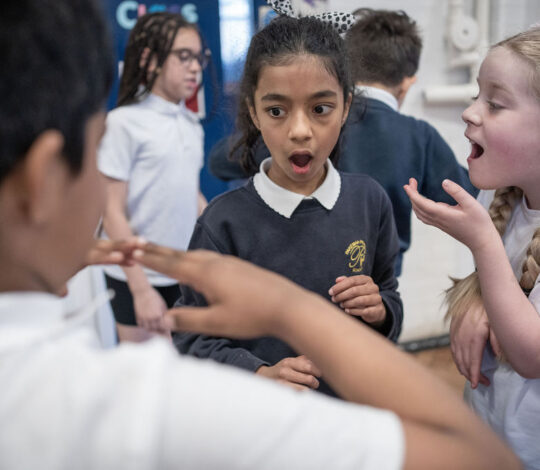How dance & movement enhances children’s education

How dance & movement enhances children’s education
By Tarika H Ingram (Wiggle)
The power of the arts in education
I have always believed that using dance, drama, or music in teaching is one of the best ways to bring things alive for children. Rather than being taught a book, idea, or concept, they get to experience it. This opens up a whole new world for them, something that is true for both those performing as well as those watching.
The St. Thomas of Canterbury project
At the end of January, I was asked to run a two-day project at St. Thomas of Canterbury Catholic Primary School in West London. The project was with Year 3 children and was part of The David Shepherd Wildlife Foundation’s mask competition that the school enters every year.
The theme was ‘Wild Wonders,’ and Nicola, the art teacher, along with the children, had created massive, colourful tissue paper head masks of five different animals – an elephant, a dog, a tiger, a rhinoceros, and a snow leopard. The masks were completed with beautiful fabric unique to each animal and extended backwards, held together with sticks to make the body of the animal (think Chinese Dragons, but with animals instead). The effect was truly magnificent.
Since the school had done well in the competition the year before, Nicola wanted to take things a step further and make the animals move. So, armed with the vision and details of the project, I set off to make these wonderful masks come to life.
Day 1: learning movement and rhythm
The focus of the first day was to teach the children a set of movement patterns and accompanying rhythms. Each animal had a distinct rhythm and footwork pattern that went with its character and an accompanying percussion element of claves and shakers.
Once they had been divided into dancers and musicians, each group did a practice run with the masks. This was no small feat for them as some of the masks were quite heavy! However, the care they took to carry the masks whilst performing with them showed the pride they felt in being a part of the project.
I spent the day with each animal group practicing their movement patterns, brushing up the musicians’ percussion, and showing the children how to handle their masks effectively. I was very impressed to see how quickly they picked up the different elements of the performance in such a short period of time. Nicola and I sat down at the end of the day and discussed how the performance would go ahead as the parents had been invited to come along as well.
Day 2: rehearsal and performance
A couple of days later, I returned to rehearse the children and prepare them for their performance. The teachers were really helpful in getting the children to remember their footwork and percussion, and the TAs helped with patching up little dents in the delicate animal masks. It became a wonderful team effort by the time the first performance came around.
Nervous but excited, the musicians sat waiting for their cues. The dancing animals came out one at a time, performing their footwork and keeping in time with the musicians. The rest of the school hadn’t seen the finished masks, so there were gasps of delight and whispers of wonder as each animal appeared. At the end, the animals all marched back in one long parade to the applause of the audience.
Learning a piece of choreography and performing it can be nerve-wracking at the best of times, but when the children performed a second time for the parents, they were a lot more confident about performing to an audience. I was incredibly proud of them for having learned and performed their work in the short space of two days. Most importantly, they enjoyed themselves and worked really well together as a team, whether they were a musician or a dancing animal.
A winning moment
Nicola got in touch recently to tell me that the school had won The David Shepherd Wildlife Foundation’s mask competition. I was over the moon. This, for me, once again proves the fact that the arts are an invaluable way of reaching out to children, a way of bringing things to life in a way that stays with them for a long time to come.
Feedback from Nicola Chance, Art Specialist Teacher
“It was a pleasure working with all of you; I appreciate your enthusiasm and flexibility to make the project a success. Importantly, the children had a brilliant time working on the project and really feel that art makes a difference!”
“I heard from the reception teacher that one of her children was playing with some plastic animals yesterday (nearly four weeks later) and went to find some instruments to tap out a rhythm for the animals to move in a certain way. She was even trying to get the different feet to move to the beat she was creating! I think that story shows the impact that the performance had, and it will last in their memories for a long time.”

